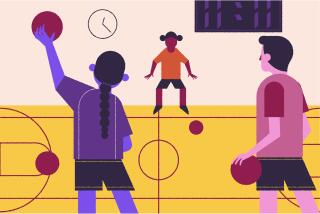Junior League Battles Elitist Image
WASHINGTON — Bone china and brooches and sterling silver for sale. Special guest rooms at New York’s Waldorf-Astoria. Cookbooks and calligraphy and a fancy private boarding school in the Virginia hunt country.
It’s no surprise to find these advertisements in a recent issue of the Junior League Review. But there’s another side these days to the genteel club founded by turn-of-the-century debutantes to improve the lot of poor children.
More often than not, today’s league members work full time. They are crusading for “membership diversity.” They’ve got a black lobbyist on Capitol Hill. And they’re promoting issues such as mandated job leaves for new parents, pitting themselves against conservatives and corporations.
That’s not exactly the profile that comes to mind when one thinks of the Junior League. “WASP to the max” is the more apt description given by Karen Hendricks, the lobbyist.
But she is living evidence that league membership is no longer reserved for “the white, upper-middle-income woman who doesn’t work outside the home, has two kids and a Volvo.”
Nonetheless, much work remains if the group is to cast off its image as an elitist clique preoccupied with balls, bazaars and fashion shows.
“There’s a lot of old baggage,” said Hendricks, director of the league’s 4-year-old public policy office in Washington.
She knows this firsthand, thanks to encounters with people who are nonplussed simply by the color of her skin.
Once Hendricks was waiting to see a senator with two other visitors--a white woman and a white man. An aide arrived and approached the white woman.
“You must be with the Junior League,” the aide said. The woman demurred. The aide next went over to the white man. Wrong again. It finally dawned on her that, yes, a black person was representing the league.
The Junior League did not get its white-gloved, upper-crust image for nothing. But members say the substance of the organization has been ignored by society reporters less interested in service projects than the cookbooks and cotillions that pay for them. Their purpose, they maintain, is far from frivolous and has not wavered since 1901.
That was the year Mary Harriman, sister of the late New York Gov. Averill W. Harriman, and her friend Nathalie Henderson founded the Junior League to aid the slum tenement movement begun by Jane Addams. The young women and their debutante friends were in such demand as fund-raisers and volunteers that by 1907 their mission had shifted to a broader goal of neighborhood improvement.
Now there are 277 Junior Leagues with 188,000 members in the United States, Canada, Mexico and Great Britain under the auspices of the Assn. of Junior Leagues International. More than half of the active members (as opposed to sustainers, who have “graduated” at age 45 to different types of community work) are employed full time.
Individual leagues run the gamut from two that have gone on record in favor of abortion rights to others that stick to tea and symphonies. Museum programs and historical preservation remain hallmarks of some local leagues. But others pursue grittier tasks that take them into the nation’s shelters, schools, hospitals and juvenile courts.
They are working with AIDS babies, foster children, handicapped children, the homeless, battered women, alcoholic women and high-risk adolescents. They are serving as mentors to disadvantaged young girls and trying to prevent teen-age pregnancy. They have founded and staffed child-care centers and referral networks. They are even fighting pollution.
Reflecting the times, the association has a special program to help volunteers translate their skills into paying jobs. But the greatest shifts in recent years have been efforts to broaden membership and develop some lobbying clout.
Since forming a diversification committee in 1978, the association has been phasing out onerous entry requirements and stressing the need to attract minority women.
In the past, according to former association president Maridel Moulton of Moraga, Calif., leagues could impose a residency requirement of any number of years, and some sought eight or nine sponsors and letters of reference.
The most a league can now require from a prospective member is a year of residency and four sponsors, who usually serve now as mentors rather than gatekeepers. Incoming members also must be under 40 and committed to voluntarism.
There are no demographic statistics available, so it’s hard to say whether the membership is less white or wealthy as a result of the changes. According to Moulton, black women have been members for decades but “the numbers haven’t been there. . . . You will still probably find some Junior Leagues that have no blacks. And there are some with a representative number from their communities.”
Local leagues concerned about foster care prompted the association to take its first political positions in 1978. Since then, guided by initiatives from its grass roots, the association has pressed the federal government on welfare reform, civil rights, child care and other social issues.
A staid reputation, close community ties and well-placed corporate and political connections make the Junior League a valued ally.
“They are the backbone of upper-middle class voluntarism. They bring the stamp of approval of mainstream America,” said Judith Lichtman, president of the Women’s Legal Defense Fund. “Their women represent some of the more Establishment sectors of society. Very often they have entree to members of Congress that we don’t have. They are truly nonpartisan. They don’t necessarily just speak to progressives or liberals.”
The High Point, N.C., league brought many of these qualities to bear in a successful battle to prevent chemical dumping in a creek feeding the city’s primary water supply. At issue was a permit sought by Ashland Chemical to build an industrial chemical repackaging plant.
Alerted by Water Watch, a tiny local citizens group, league members researched Ashland’s record and the effect of the chemicals in question. They announced a hearing on the permit in a newspaper ad, at PTA meetings and church suppers, in flyers and phone calls. They even offered to chauffeur people who were afraid to go downtown at night.
“The publicity was terribly important because most people in town were not aware of the danger this particular plant represented,” said June Stackhouse, acting president of Water Watch. “We were a small core group of 35 or 40. They had a lot of contacts . . . a lot of connections with people with clout. They helped us pack the hearing and it really paid off.”
Many leagues are at the cutting edge of social issues, Hendricks says, despite the persistent image of “little ladies” donating time to innocuous, insignificant projects.
One illustration of the image gap:
In 1986, the association was pushing for bills to expand the federal child-care role and require businesses to make unpaid, job-protected leaves available to new parents. Both measures gave conservatives apoplexy.
But that was also the year a Washington lecture agency advertised in the league magazine that it specialized “in the unique needs of Junior League Programs” with speakers such as Charlton Heston and Phyllis Schlafly, both rock-ribbed conservatives.
Which is not to say a more traditional league wouldn’t welcome speakers such as Heston and Schlafly. Maybe the one in Richardson, Tex., for example.
The 450-member league in a Dallas suburb cares for a historic home, tutors illiterate adults and helps pay for and run a summer recreation program for handicapped children. Recently it sponsored a benefit performance by a troupe of disabled puppeteers. It also gives money to hard-pressed community groups serving battered women, the homeless and others.
What pays for all of this? An annual charity ball. Last year it netted $175,000, said league President Meredith McClure.
McClure, 37, a part-time administrative assistant with two children, characterized her members as “very conservative” and said they are not particularly active in politics. But she says the league is in close touch with the national association and generally supports its positions.
“The one thing we can always seem to agree on is child welfare,” she said.
McClure says that even includes support for the federal parental leave bill, a favorite target of conservatives and the business community that co-sponsors or underwrites many league projects and with which so many members are closely associated.
“These women are business owners or are married to business owners. They can do what they do because of money from business,” Hendricks explained.
Nevertheless, when parental leave came up in the House in May, Hendricks was at the entrance to the chamber, grabbing members to champion the bill--right next to lobbyists from the U.S. Chamber of Commerce and other business groups intent on blocking passage. They were unsuccessful.
League officials maintain their alliance with feminist and medical groups on parental leave is nothing unusual, given an 89-year tradition of concern for children and families. But they do acknowledge an evolution in tactics since the long-ago day that Mary Harriman walked into a tenement house in New York City.
“You start wondering how you can change the system,” said Sally Orr of New York City, a member for nearly 35 years. “The Junior Leagues realized they had to influence the regulatory and legislative process to get changes in their community.”
Suzanne Plihcik of Greensboro, N.C., who became president of the association in May, says political muscle is now very important to the leagues’ mission. Among the reasons: Women have less time to volunteer, while social problems are increasingly broad and complex.
“We have looked at more comprehensive and effective approaches to doing the same things,” Plihcik said. “It is imperative that we change with the world. But our basic values and goals remain the same. Everything is aimed at community improvement.”


